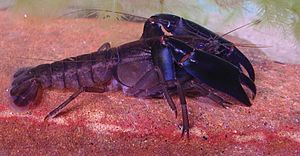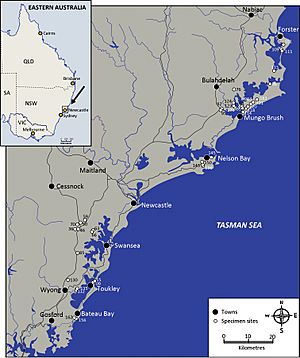Eastern swamp crayfish facts for kids
Quick facts for kids Eastern swamp crayfish |
|
|---|---|
 |
|
| Gramastacus lacus | |
| Scientific classification | |
| Kingdom: | |
| Phylum: | |
| Subphylum: | |
| Class: | |
| Order: | |
| Superfamily: | |
| Family: |
Parastacidae
|
| Genus: |
Gramastacus
|
| Species: |
G. lacus
|
| Binomial name | |
| Gramastacus lacus McCormack, 2014
|
|
 |
|
| Distribution in Eastern Australia | |
The eastern swamp crayfish (Gramastacus lacus) is a small freshwater crayfish. It lives in the coastal areas of New South Wales, Australia. This crayfish is special because of its unique features. These include large male reproductive parts, raised ridges near its eyes, a flattened body shell, and long claws.
Contents
What's in a Name?
The scientific name for this crayfish is Gramastacus lacus. The second part, lacus, comes from a Latin word meaning "lake". This name was chosen because the crayfish is often found in coastal lakes. Before it got its official scientific name, people sometimes called it the "lake yabby".
How Was It Found?
The first eastern swamp crayfish were discovered in a special wetland area. This area is called the Ramsar wetlands within Myall Lakes National Park. Scientists started collecting more of these crayfish in 2005. This was part of a bigger project called the Australian Crayfish Project.
What Does It Look Like?
The eastern swamp crayfish is quite small. It usually weighs about 4 to 5 grams (around 0.14 to 0.18 ounces). The longest ones found are about 21.32 millimeters (0.84 inches) long.
- Its Body:*
- It has a long, narrow snout with a small spine at the tip.
- Its tail section is smooth and not armored. It has thin, stiff hairs.
- The tail fan is shaped like a "U".
- The first pair of claws are smooth and longer than its other legs.
- Boys vs. Girls:*
Male and female eastern swamp crayfish look a bit different. This is called sexual dimorphism. Males have much bigger claws than females. Females, on the other hand, have wider tail sections.
- Colors:*
The color of these crayfish can vary.
- The top part of their body and tail is often light brown, green, tan, or steel blue.
- They might have red or cream-colored spots.
- The head area is usually black or brown on top. It often has lighter blue highlights along the sides.
- The underside of their body is usually cream-colored or clear.
- Their main claws are black to dark blue. They have bright blue edges and red joints.
Young crayfish are usually a uniform light blue color.
Where Do They Live?
Eastern swamp crayfish live in different groups along the Central and Mid North Coast of New South Wales, Australia. They are found in low-lying coastal areas. These areas are usually between 3 and 48 meters (10 to 157 feet) above sea level.
- Their Home:*
They typically live in temporary wetlands. These include small creeks and swamps. The water in these places is usually no deeper than 1 meter (3 feet). The number of crayfish in an area can change. You might find between 1 and 35 crayfish per square meter, depending on the environment.
How Do They Behave?
Unlike some other crayfish, the eastern swamp crayfish digs burrows. They do this to survive when their watery homes dry up during the dry season.
- Burrowing:*
- Their burrows are usually between 450 and 750 millimeters (18 to 30 inches) deep.
- Some burrows have been found as deep as 1 meter (3 feet).
- Sometimes, a burrow might have a round room at the end. It might also be capped with mud.
- Occasionally, a young crayfish will share a burrow with an adult.
- Staying Safe:*
Gramastacus lacus often hides in thick reeds and grass near the shore. This helps them avoid predators.
- Their predators include speckled longfin eels, gudgeons, giant water bugs, eastern long-necked turtles, and Australian water dragons.
- Many types of birds also hunt them.
The only crayfish that go into deeper water are those that have recently shed their skin. They likely do this to avoid being eaten.
- Defense:*
When in the water, the crayfish use their large claws to defend themselves. But when they are on land, they usually scuttle backward very quickly to escape danger.
How Do They Reproduce?
The eastern swamp crayfish breeds when the temporary pools they live in are flooded. This usually starts in early August.
- Eggs and Young:*
- Females lay between 30 and 150 eggs.
- The eggs are dark olive green or dark purple.
- The eggs hatch after 6 to 8 weeks, usually in late October.
What Threats Do They Face?
The eastern swamp crayfish lives in areas of Australia that are developing very quickly. This means their homes are at risk. Swamps and wetlands are often drained to build farms, factories, houses, and golf courses.
- Other Dangers:*
The species is also threatened by an invasive crayfish called the common yabby (Cherax destructor). This yabby has been introduced into the eastern swamp crayfish's habitats, like the Wamberal Lagoon.

